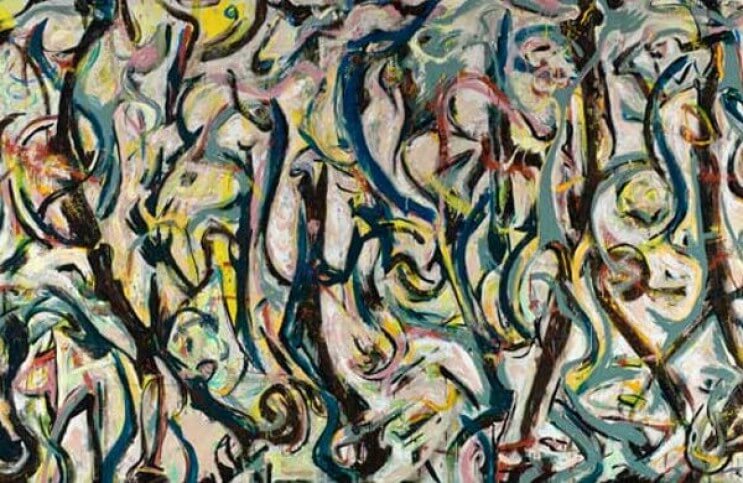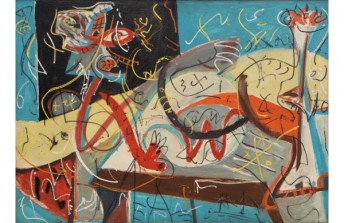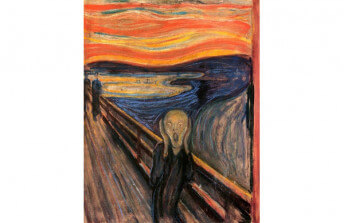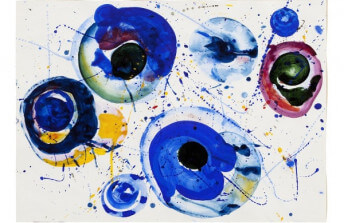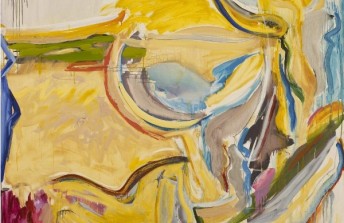Pollock and Motherwell: Legends of Abstract Expressionism at the Nelson Atkins Museum of Art
Jul 13, 2017
A recently opened exhibition in Kansas City, Missouri, examines Abstract Expressionism from the perspective that less is more. The exhibition, Pollock and Motherwell: Legends of Abstract Expressionism, features only two paintings. The first is Mural, painted in 1943-44 by Jackson Pollock. The second is Elegy to the Spanish Republic, No. 126, part of a series begun in 1965 by Robert Motherwell. Both paintings are monumental in size, and each stands as an iconic example of the aesthetic position of the artist who painted it. Presented together in this unique fashion they illuminate a fascinating period in history by delvingboldly into the complicated visual strategies employed by two giants of one of the most influential movements in 20th Century American art.
A Legendary Beginning
The story of the creation of Mural is a bona-fide legend of American art. The story begins with the art collector Peggy Guggenheim who was looking for an artist who would be capable of creating a large-scale artwork to hang in the massive foyer of her luxury apartment in New York City. Clued in to his work by her assistant, Guggenheim took a chance on a relatively unknown artist named Jackson Pollock. At the time, Pollock was only just beginning to make a name for himself painting quasi-abstract, totemic compositions that were relatively small in scale. This commission, which Guggenheim stipulated must cover the entire wall, which was nearly six meters long and two-and-a-half meters tall, offered him a chance to reach far outside of his comfort zone.
Pollock tore down walls to accommodate the massive canvas in his studio. But once he got the canvas prepared he became blocked. Guggenheim was paying him a monthly stipend while he worked on the piece, but after many months Pollock had not painted a single mark. Under increasing pressure from Guggenheim, he finally had his breakthrough. In a whirlwind of activity he created a dynamic abstract manifestation of what he later described as a “stampede...[of] every animal in the American West.” In the process of creating the piece, Pollock pioneered the splatter technique that would later define his style. This painting also marked his first use of the quick, intuitive, automatic technique that would later be described as Action Painting. Though suggestively figurative in places, Mural also marked the beginning of the drastic transition Pollock underwent into pure abstraction. The painting caused an uproar when it was first exhibited, and helped cement a reputation for Pollock as a major emerging talent.
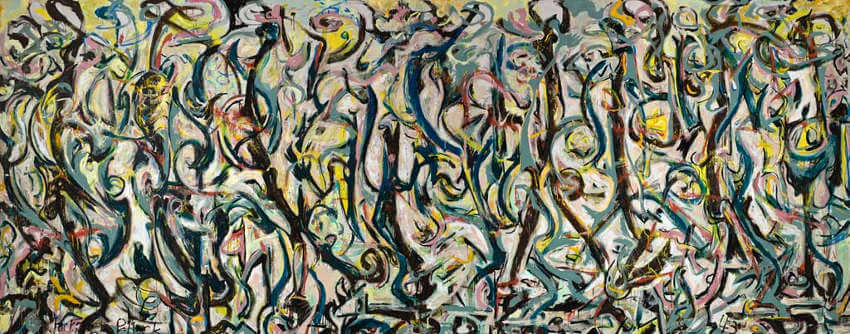 Jackson Pollock - Mural, 1943. Oil and casein on canvas, 95 5/8 x 237 3/4 inches. Gift of Peggy Guggenheim, 1959.6. University of Iowa Museum of Art, Iowa City. Reproduced with permission from The University of Iowa Museum of Art. Photograph courtesy the J. Paul Getty Museum, Los Angeles, 2014
Jackson Pollock - Mural, 1943. Oil and casein on canvas, 95 5/8 x 237 3/4 inches. Gift of Peggy Guggenheim, 1959.6. University of Iowa Museum of Art, Iowa City. Reproduced with permission from The University of Iowa Museum of Art. Photograph courtesy the J. Paul Getty Museum, Los Angeles, 2014
A Conversation Across Decades
Guggenheim donated Mural to the University of Iowa in 1948, after deciding to move to Europe and realizing she would have no space large enough in her new home to display the massive painting. Mural stayed at the University of Iowa Museum of Artfor two decades, alone in its singular vastness, until 1972, when the director of the museum decided to commission another monumental work that could hang in conversation with it. Robert Motherwell was the artist chosen for this heady task. Although he was considered one of the most prominent members of the Abstract Expressionist movement, Motherwell had developed a technique and a visual language distinctly different from that of Jackson Pollock.
The work Motherwell painted in response to the commission, titled Elegy to the Spanish Republic, No. 126, is considered one of the most profound expressions of his mature style. Like Pollock, Motherwell was attracted to the idea of automatism, or the act of painting directly from the subconscious. But unlike Pollock, Motherwell was also interested in the power of defined shapes and the purity of bold fields of color. This painting, one of a multitude of works Motherwell createdin memory of the Spanish Civil War, contains a sparse alphabet of black ovals and vertical shapes. The shapes fluctuate between organic and geometric states, and the muted color palette evokes a sensation of deep, somber emotion. Intentionality is obvious in its composition, and yet the bold splotches, casual drips, and rough edges, all left behind by his loose, intuitive, physical painting technique, still places it firmly in the Abstract Expressionist tradition to which Motherwell belonged.
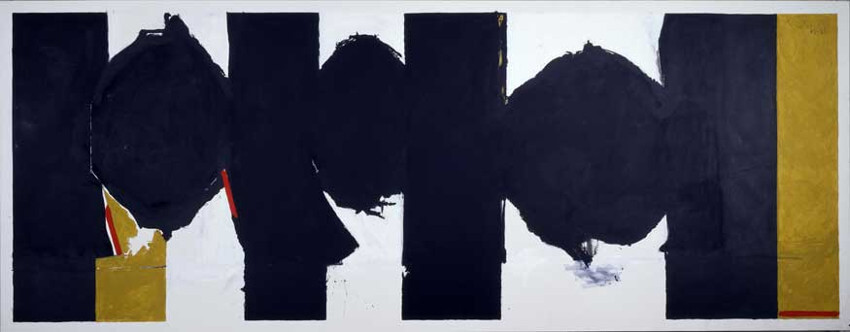 Robert Motherwell - Elegy to the Spanish Republic, No. 126, 1965-75. Acrylic on canvas, 77 3/4 x 200 1/4 inches. Purchased with the aid of funds from The National Endowment for the Arts with matching funds and partial gift of Robert Motherwell. University of Iowa Museum of Art, Iowa City. © Dedalus Foundation, Inc. Licensed by VAGA, New York, NY
Robert Motherwell - Elegy to the Spanish Republic, No. 126, 1965-75. Acrylic on canvas, 77 3/4 x 200 1/4 inches. Purchased with the aid of funds from The National Endowment for the Arts with matching funds and partial gift of Robert Motherwell. University of Iowa Museum of Art, Iowa City. © Dedalus Foundation, Inc. Licensed by VAGA, New York, NY
Larger Than Life
Abstract Expressionism was full of larger than life personalities, and Pollock and Motherwell were two of the largest personalities to come out of it. They are considered by many people to be shamanistic: presenting visual myths that connect modern civilization with its ancient, universal roots. Pollock in particular was one of the first American art stars—an artist who became as much of a celebrity as any movie star of his time. And scale was also integral to the works the Abstract Expressionists created. Thanks to their sheer size alone, these two paintings are in themselves monuments to the movement. They are among the largest examples of single canvases painted by these artists, or by any other artist of their era. Seeing them together in one place at one time is astounding, and gives a tremendous amount of weight to the largess of the ideas they represent.
Visitors to Pollock and Motherwell: Legends of Abstract Expressionism will be especially glad to see the bright, vivid condition Mural is currently in, since it recently underwent a two-year restoration by the J. Paul Getty Museum in Los Angeles. The unconventional materials Pollock used, combined with his tendency to sometimes use unprimed surfaces, led to a great deal of deterioration in the colors as well as in the overall condition of the work over time. Its restoration has returned it to its original pristine condition. Pollock and Motherwell: Legends of Abstract Expressionism runs through to 29 October 2017 at the Nelson Atkins Museum of Art in Kansas City, Missouri. The museum is closed Monday and Tuesday. Admission is free.
Featured image: Jackson Pollock - Mural (detail), 1943. Oil and casein on canvas, 95 5/8 x 237 3/4 inches. Gift of Peggy Guggenheim, 1959.6. University of Iowa Museum of Art, Iowa City. Reproduced with permission from The University of Iowa Museum of Art. Photograph courtesy the J. Paul Getty Museum, Los Angeles, 2014.
By Phillip Barcio
